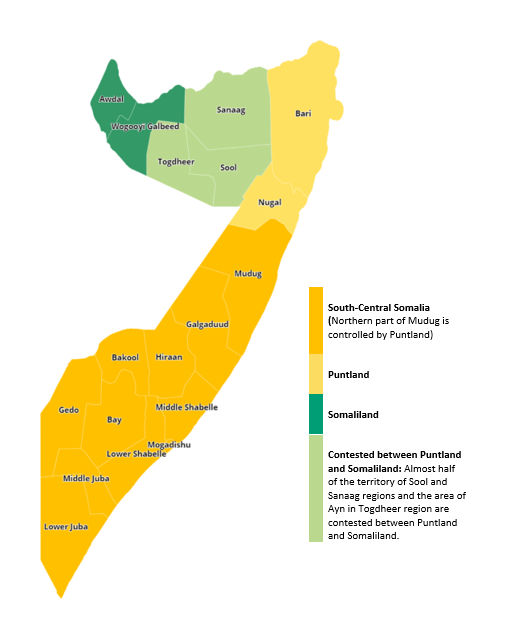COMMON ANALYSIS
Last update: August 2023
Somalia is a Federal State composed of two levels of government: the federal government and the federal member states (FMS), which include both state and local governments. FMS also dispose their own constitutions and armed forces. [Actors, 2.1. p. 23]
Since the 15 May 2022 election, Hassan Sheikh Mohamud (HSM) is the new president of Somalia. On 7 August 2022, the Parliament endorsed the new Somali Government, comprising 26 Ministers, 24 State Ministers and 25 Deputy Ministers. [Security 2023, 1.1., p. 19]
Somalia is de-facto ruled by a gentlemen agreement among the major clan-families that dominate the country. Based on this agreement, also known as the 4.5 power-sharing formula, key positions in the State apparatus, including parliamentary seats, are (more or less) proportionally distributed among the four main clan families as well as the 0.5 quota representing minorities. [Actors, 2.1., pp. 24-25]
South-Central Somalia includes the following FMS: Jubbaland, South-West, Benadir, Hirshabelle and Galmudug. Mudug region is divided between Galmudug and Puntland, with Galmudug controlling the southern half of the region. [Security 2023, 2.5.2., p. 147]
Puntland, as an autonomous state within the Somalia Federal State, was established on 1 August 1998 as an entity representing clans belonging to the Harti clan collective. Puntland has developed significant institution-building and governance mechanisms. However, it continues to be affected by security, humanitarian, political, and socio-economic challenges. [Actors, 7.6., p. 102]
Somaliland declared its independence in 1991 while the civil war was occurring in the rest of Somalia [Actors, 7.7., p. 108]. The backbone of Somaliland’s administration was drawn from the Somali National Movement (SNM), comprising several Isaaq clans [Actors, 3.4.2. p. 54]. Ever since, Somaliland has embarked on an institution-building and democratisation process, combining, in a hybrid entity, traditional and modern forms of governance that make it stand out compared to other parts of Somalia [Actors, 7.7. p. 108]. Somaliland remains largely internationally unrecognised, despite a recent increase in the number of states with which it holds diplomatic relations [Actors, 7.7.1., p. 109; KSEI 2021, 3., p. 72].
In terms of territorial control and influence, some areas of Sool and Sanaag regions and the area of Ayn (Togdheer region) are contested between Somaliland and Puntland [Security 2023, 1.2., p. 22; Actors, 7.7.1., p. 110].
The following map indicates roughly the macro-zones of Somalia (South-Central Somalia, Somaliland, Puntland) (Figure 2), as described above. This illustration intends to provide the user of the present guidance with a general depiction of these areas on the map. For information regarding the territorial control of different actors in Somalia and/or the contested territories, see the chapter 2. Actors of persecution or serious harm and the map (Figure 3), included in that section.
Figure 2. Macro-zones of Somalia

